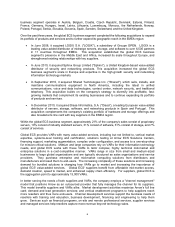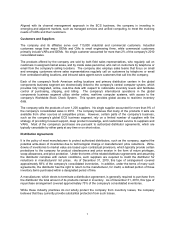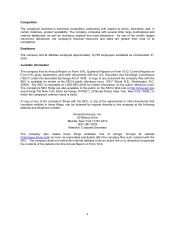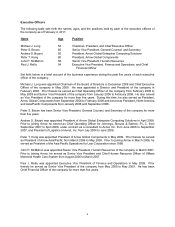Arrow Electronics 2010 Annual Report Download - page 18
Download and view the complete annual report
Please find page 18 of the 2010 Arrow Electronics annual report below. You can navigate through the pages in the report by either clicking on the pages listed below, or by using the keyword search tool below to find specific information within the annual report. 16
of the company’s internal controls on a regular basis, these controls may not always be effective. There
are inherent limitations on the effectiveness of internal controls, including collusion, management
override, and failure in human judgment. In addition, control procedures are designed to reduce rather
than eliminate financial statement risk. If the company fails to maintain an effective system of internal
controls, or if management or the company’s independent registered public accounting firm discovers
material weaknesses in the company’s internal controls, it may be unable to produce reliable financial
reports or prevent fraud, which could have a material adverse effect on the company’s business. In
addition, the company may be subject to sanctions or investigation by regulatory authorities, such as the
SEC or the NYSE. Any such actions could result in an adverse reaction in the financial markets due to a
loss of confidence in the reliability of the company’s financial statements, which could cause the market
price of its common stock to decline or limit the company’s access to capital.
The company relies heavily on its internal information systems, which, if not properly functioning,
could materially adversely affect the company’s business.
The company's current global operations reside on multiple technology platforms. These platforms are
subject to electrical or telecommunications outages, computer hacking, or other general system failure,
which could have a material adverse effect on the company's business. Because most of the company's
systems consist of a number of legacy, internally developed applications, it can be harder to upgrade and
may be more difficult to adapt to commercially available software.
The company is in the process of converting its various business information systems worldwide to a
single Enterprise Resource Planning system. The company has committed significant resources to this
conversion, and is expected to be phased in over several years. This conversion is extremely complex, in
part, because of the wide range of processes and the multiple legacy systems that must be integrated
globally. The company is using a controlled project plan that it believes will provide for the adequate
allocation of resources. However, such a plan, or a divergence from it, may result in cost overruns,
project delays, or business interruptions. During the conversion process, the company may be limited in
its ability to integrate any business that it may want to acquire. Failure to properly or adequately address
these issues could impact the company's ability to perform necessary business operations, which could
materially adversely affect the company’s business.
The company may be subject to intellectual property rights claims, which are costly to defend,
could require payment of damages or licensing fees and could limit the company’s ability to use
certain technologies in the future.
Certain of the company’s products include intellectual property owned by the company and/or its third
party suppliers. Substantial litigation and threats of litigation regarding intellectual property rights exist in
the semiconductor/integrated circuit and software industries. From time to time, third parties (including
certain companies in the business of acquiring patents not for the purpose of developing technology but
with the intention of aggressively seeking licensing revenue from purported infringers) may assert patent,
copyright and/or other intellectual property rights to technologies that are important to the company’s
business. In some cases, depending on the nature of the claim, the company may be able to seek
indemnification from its suppliers for itself and its customers against such claims, but there is no
assurance that it will be successful in obtaining such indemnification or that the company is fully protected
against such claims. In addition, the company is exposed to potential liability for technology that it
develops itself for which it has no indemnification protections. In any dispute involving products that
incorporate intellectual property developed or licensed by the company, the company’s customers could
also become the target of litigation. The company is obligated in many instances to indemnify and defend
its customers if the products or services the company sells are alleged to infringe any third party’s
intellectual property rights. Any infringement claim brought against the company, regardless of the
duration, outcome or size of damage award, could:
• result in substantial cost to the company;
• divert management’s attention and resources;
• be time consuming to defend;
























